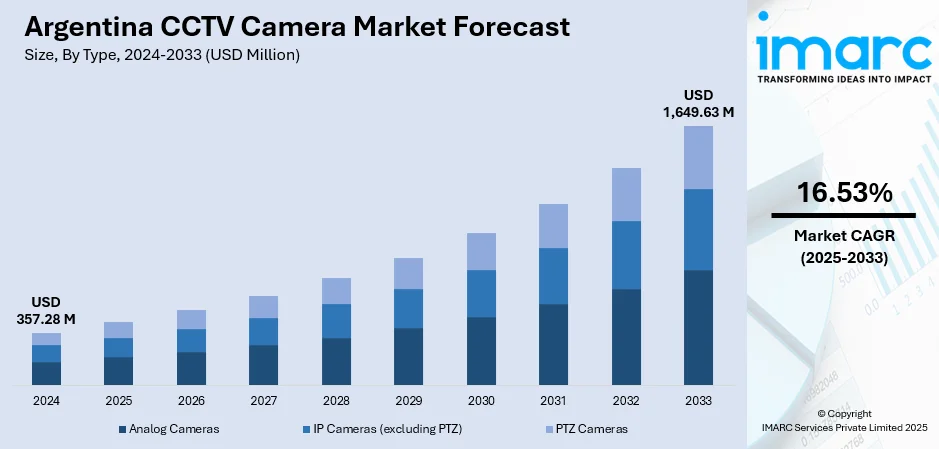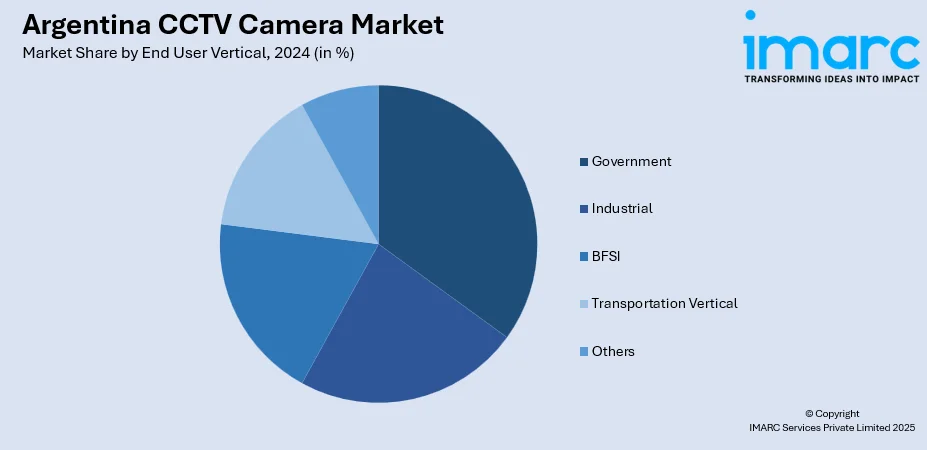
Argentina CCTV Camera Market Size, Share, Trends and Forecast by Type, End User Vertical, and Region, 2025-2033
Argentina CCTV Camera Market Overview:
The Argentina CCTV camera market size reached USD 357.28 Million in 2024. Looking forward, the market is expected to reach USD 1,649.63 Million by 2033, exhibiting a growth rate (CAGR) of 16.53% during 2025-2033. The market is expanding due to rising security concerns, technological advancements, and growing adoption across residential, commercial, and public infrastructure. Enhanced features such as AI-based analytics and remote monitoring are also boosting demand, while supportive government initiatives further encourage installation. These factors collectively influence the competitive dynamics of the Argentina CCTV camera market share.
|
Report Attribute
|
Key Statistics
|
|---|---|
|
Base Year
|
2024
|
|
Forecast Years
|
2025-2033
|
|
Historical Years
|
2019-2024
|
| Market Size in 2024 | USD 357.28 Million |
| Market Forecast in 2033 | USD 1,649.63 Million |
| Market Growth Rate 2025-2033 | 16.53% |
Argentina CCTV Camera Market Trends:
Rising Security Concerns and Crime Prevention Efforts
Increasing incidents of theft, vandalism, and other criminal activities across urban and rural areas are driving the demand for CCTV cameras in Argentina. Residential and commercial premises owners are making major investments in surveillance systems to improve safety and ward off would-be criminals. CCTV solutions are also being implemented in transport hubs, schools, and government buildings as one of the comprehensive security arrangements in these facilities. Authorized law enforcement organizations are taking advantage by monitoring in real-time and gathering evidence using them. Moreover, an increased propensity among the citizens concerning the usefulness of surveillance technology is encouraging adoption. This growing focus on proactive crime prevention, supported by community safety programs and private sector initiatives, is significantly contributing to the Argentina CCTV camera market growth.

To get more information on this market, Request Sample
Technological Advancements and Smart Surveillance Features
Rapid technological advancements in the CCTV industry are driving market growth in Argentina. Contemporary systems currently have high-definition imaging, night vision, motion detection, and AI-assisted analytics to ensure correct threat scanning and more rapid response time. Contextual functionality could include integration with cloud storage, which enables easy access to footage, and mobile applications enable real-time remote monitoring. Facial recognition, car registration readers, and automatic alert smart cameras are becoming popular with business owners, municipalities, and homeowners. The innovations enhance the efficiency of the security operations at the expense of operational costs. The growing trend toward integrating CCTV systems with broader smart building and IoT networks is further boosting demand, making technology-driven solutions a key factor shaping the Argentina CCTV camera market.
Government Initiatives and Infrastructure Development
Government-driven security programs and infrastructure upgrades are significantly supporting CCTV adoption in Argentina. Authorities are implementing surveillance networks in public areas to enhance safety and streamline urban management. Projects for smart cities, modernization of transportation hubs, and improved public service facilities often include large-scale CCTV deployments. In addition, regulatory guidelines and subsidies for security installations in sensitive zones, such as schools, hospitals, and critical utilities, encourage adoption among both public and private entities. Partnerships between government agencies and technology providers are helping expand coverage and bring advanced monitoring capabilities to more regions. This alignment of policy support and infrastructure investment plays a pivotal role in driving consistent growth in the market.
Argentina CCTV Camera Market Segmentation:
IMARC Group provides an analysis of the key trends in each segment of the market, along with forecasts at the country and regional levels for 2025-2033. Our report has categorized the market based on type and end user vertical.
Type Insights:
- Analog Cameras
- IP Cameras (excluding PTZ)
- PTZ Cameras
The report has provided a detailed breakup and analysis of the market based on the type. This includes analog cameras, IP cameras (excluding PTZ), and PTZ cameras.
End User Vertical Insights:

- Government
- Industrial
- BFSI
- Transportation Vertical
- Others
A detailed breakup and analysis of the market based on the end user vertical have also been provided in the report. This includes government, industrial, BFSI, transportation vertical, and others.
Regional Insights:
- Buenos Aires Region
- Litoral Region
- Northern Region
- Cordoba Region
- Cuyo Region
- Patagonia Region
The report has also provided a comprehensive analysis of all the major regional markets, which include Buenos Aires Region, Litoral Region, Northern Region, Cordoba Region, Cuyo Region, and Patagonia Region.
Competitive Landscape:
The market research report has also provided a comprehensive analysis of the competitive landscape. Competitive analysis such as market structure, key player positioning, top winning strategies, competitive dashboard, and company evaluation quadrant has been covered in the report. Also, detailed profiles of all major companies have been provided.
Argentina CCTV Camera Market News:
- In January 2025, Ajax Systems, a global technology firm and Europe’s largest producer of security solutions, entered into a collaboration with S.P. Seguridad Privada S.A. In Argentina, S.P. Seguridad Privada S.A. is recognized as a prominent supplier of alarm systems, surveillance cameras, access control equipment, fire detection solutions, and professional monitoring services.
Argentina CCTV Camera Market Report Coverage:
| Report Features | Details |
|---|---|
| Base Year of the Analysis | 2024 |
| Historical Period | 2019-2024 |
| Forecast Period | 2025-2033 |
| Units | Million USD |
| Scope of the Report |
Exploration of Historical Trends and Market Outlook, Industry Catalysts and Challenges, Segment-Wise Historical and Future Market Assessment:
|
| Types Covered | Analog Cameras, IP Cameras (excluding PTZ), PTZ Cameras |
| End User Verticals Covered | Government, Industrial, BFSI, Transportation Vertical, Others |
| Regions Covered | Buenos Aires Region, Litoral Region, Northern Region, Cordoba Region, Cuyo Region, Patagonia Region |
| Customization Scope | 10% Free Customization |
| Post-Sale Analyst Support | 10-12 Weeks |
| Delivery Format | PDF and Excel through Email (We can also provide the editable version of the report in PPT/Word format on special request) |
Key Questions Answered in This Report:
- How has the Argentina CCTV camera market performed so far and how will it perform in the coming years?
- What is the breakup of the Argentina CCTV camera market on the basis of type?
- What is the breakup of the Argentina CCTV camera market on the basis of end user vertical?
- What is the breakup of the Argentina CCTV camera market on the basis of region?
- What are the various stages in the value chain of the Argentina CCTV camera market?
- What are the key driving factors and challenges in the Argentina CCTV camera market?
- What is the structure of the Argentina CCTV camera market and who are the key players?
- What is the degree of competition in the Argentina CCTV camera market?
Key Benefits for Stakeholders:
- IMARC’s industry report offers a comprehensive quantitative analysis of various market segments, historical and current market trends, market forecasts, and dynamics of the Argentina CCTV camera market from 2019-2033.
- The research report provides the latest information on the market drivers, challenges, and opportunities in the Argentina CCTV camera market.
- Porter's five forces analysis assist stakeholders in assessing the impact of new entrants, competitive rivalry, supplier power, buyer power, and the threat of substitution. It helps stakeholders to analyze the level of competition within the Argentina CCTV camera industry and its attractiveness.
- Competitive landscape allows stakeholders to understand their competitive environment and provides an insight into the current positions of key players in the market.
Need more help?
- Speak to our experienced analysts for insights on the current market scenarios.
- Include additional segments and countries to customize the report as per your requirement.
- Gain an unparalleled competitive advantage in your domain by understanding how to utilize the report and positively impacting your operations and revenue.
- For further assistance, please connect with our analysts.
 Request Customization
Request Customization
 Speak to an Analyst
Speak to an Analyst
 Request Brochure
Request Brochure
 Inquire Before Buying
Inquire Before Buying




.webp)




.webp)












